Nine years after the “Orange revolution “, Ukraine is again in the eye of the storm. Beyond all the noise and media attention generated by large demonstrations, Ukrainian reality and the factors that have led to both governments’ decision to suspend negotiations with the EU and the subsequent protests are of a complexity often not taken into account. Since its independence in 1991, the country’s authorities have had to manage the historic division that characterizes Ukraine, not only in terms of language and ethnicity, but also from a socio-economic and political point of view. This deep contradiction made impossible to successive governments to take clear steps in one or another direction when it comes to the geopolitical area in which to situate the country: Russia and the former Soviet space or the EU. In this article, I will try to shade some light on the issue, offering a range of data in order to help to understand the characteristics of the conflict of realities within the country, mainly from a sociological and economic perspective.
Sociological divide
According to the interpretation made by most of Western media, the protests and riots that are taking place this week in Ukraine correspond to the broad and majoritarian wish of the Ukrainian people to get away from Vladimir Putin´s Empire and move towards becoming a free society in the EU. According to this vision, the Ukrainian President Viktor Yanukovich took the right path choosing Association Agreement with the EU, but in the last minute he changed his mind to a great extent due to pressure from Russia and the refusal to release former Prime Minister Yulia Timoshenko from prison.
But what do Ukrainians actually want? According to a poll published by the International Institute of Sociology of Kiev made from 9 to 20 November, to the question “If there were to be a referendum on the question should Ukraine join the Customs Union with Russia, Belarus, and Kazakhstan, would you vote for it, against it, or decline to vote?”, the results showed 40.8% in favor and 33.1% opposed. Broken down by region, support for joining the Customs Union was very high in the East (64.5%), high in the South (54%), moderate in the Center (29.6), and lowest in the West (16.4%).
In contrast, when it comes to the same question but referred to a possible referendum of accession to the EU, 39,7% declared to be in favor whereas 35,1% were against. In this case, Western and Central regions are the more pro-European (66,4% an 43,4%), while in the Eastern regions only 18,4% of the polled favored the accession of Ukraine to the EU.
Economic inequalities
The areas where support to the accession to the Customs Union (CU) is higher are the ones where Russophone population is higher, and where there are also important minorities of Russian ethnic population, that go from 17,6% to 58,3% depending on the region. Consequently, one may think that the higher support to move towards Russia and its CU has an ethnic and political root in terms of a higher identification with the “Russian brother”. However, if we analyze the Ukrainian economic reality and what consequences would have for its regions a rapprochement to either Russia or the EU, the results are very revealing and provide an understanding of the reasons for the existing division.
According to a study made by the University of Nottingham, Ukraine is the country of Europe with a highest index of inequality among its regions in terms of GDP per capita, doubling the European average. Apart from Kiev (which for its situation as capital-city generates an autonomous economic inertia, situating itself much above that the rest of the regions in most of economic indicators), we see a country divided in two economic realities certainly uneven and unequal: on one side, eastern and southern regions; on the other, central and western ones. In this sense, data regarding GDP per capita show the following distribution: most of the western and southern regions (blue color) are placed in the upper part of the rank, whereas the majority of central and western regions (red color) are among the poorest.
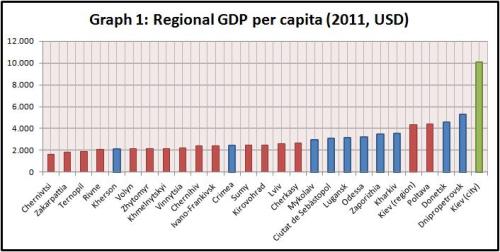 Source of data: State Statistics Service of Ukraine
Source of data: State Statistics Service of Ukraine
Aggregating regions in zones, we find that GDP per capita in the east and south is 3522 USD and 2590 USD in the center and south, a difference of 26%. This distance increases considerably if we compare the income of the richest Eastern region (Dnipropetrovsk, 5298 USD) with the poorest Western one (Chernivtsi, 1666 USD), being the former no more, no less than 3,1 times higher than the latter. In 1997 the maximum difference between regions was 2,7 times, thus an increasing interregional inequality can be observed, even more accentuate if we have into account that GDP per capita in Kiev city is 6,1 times the one in Chernivtsi.
When it comes to the average salary, according to the data of the State Statistical Service of Ukraine a similar territorial relation can be observed. With the exception of Kherson, the rest of eastern and southern regions are among the ones where salaries are higher, whereas in most of the western and central regions salaries are lower, situated all of them below the national average – 417 USD per month.
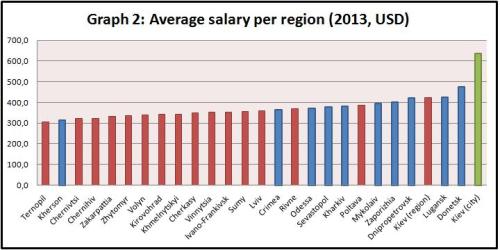 Source of data: State Statistics Service of Ukraine
Source of data: State Statistics Service of Ukraine
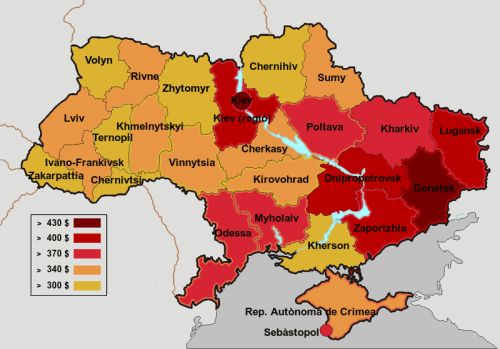
Average salary in Ukraine: regional inequalitites
If to the above mentioned factors we add the fact that precisely the regions situated in the East and South of the country are the ones that have bigger populations (representing a 51,9% of the total -Graphs 3 and 4-) we find that, even if they are only 10 administrative units out of 27, its contribution to the national GDP is 49,4% of the total. In contrast, even though in the central and western regions (Kiev apart) lives 41,9% of the population, these areas provide only with 31,7% of the Ukrainian GDP (Graph 4)
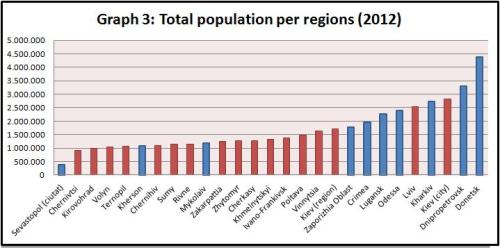
Source of data: national census (SSSU)
The causes of this inequality are very diverse, and are related mainly to the level of development of the respective regional economies. Therefore, whereas the territories of the East and South provide with a 62,7% of the total of industrial production in the country and only with a 35% of the agricultural one, for the central and western parts agriculture still plays an important role. In a similar vein, eight out of fourteen largest Ukrainian companies by revenue are based in the east or south of the country (the remaining 6, in Kiev), belonging mostly to the metallurgy, automotive or energy sectors, being Metinvest the largest one, a conglomerate owned by the oligarch of Tatar origin Rinat Akhmetov, owner also of the Shakhtar Donets football team and first fortune in the country. The south-eastern regions also lived a faster economic growth during the periods 2004-2007 and 2010-2011, even though given its bigger connection with the external markets they also suffered more the consequences of the 2008-09 financial crisis.
According to a study published by the consulting firm SygmaBleizer, the levels of indicators such as of work, technology and infrastructures quality are higher in the east than the west, thus being the production of the former ones more competitive. This is to a great extent due to the greater concentration of natural resources and bigger population in the east and south of the country. Thus, a part of Kiev, the other four cities with more than 4 million inhabitants are situated in these regions, a fact that already during the Soviet time contributed to make of the axis Donetsk-Dnipropetrovsk-Zaporozhie-Odessa one of the main centers of logistics and production of the Union. This regional duality is also reflected in the unemployment rates. According to the data published by the International Labour Organization, in 2010 the unemployment in most of the western and central regions ranged between 10% and 13%, whereas in the South and East it was below 8% -6,7% in Kiev-.
Distribution of labor between big and middle companies and smaller ones shows also very revealing data. In 2011 there were in Ukraine more workers employed in big and middle companies than in small ones, 8.2 millions against 6.5 respectively. This difference is even more visible in the Eastern industrial regions like Donetsk, where the relation is 940 thousands / 511 thousands, or Dnipropetrovsk, 770 thousands/450 thousands. In contrast, the regions with higher rates of unemployment (most in the center and west) show an opposed ratio, and small business predominate in all of them.
These differences between regions have their impact on poverty levels. Among the poorest regions, three out of four are in the center/west, all of them with a 40% of population or more under poverty threshold. Paradoxically though, while according to most of the indicators the Eastern and Southern regions have a more favorable economic situation, they are on the bottom of the country when it comes to quality of government, independency of the judiciary, or the indexes regarding criminality and corruption. In addition, live conditions in the South and East are harder, as it is shown by the levels of alcoholism, suicide, drug addiction, or prevalence of VHI infection, higher in all the cases than the national average.
Ukraine, between Russia and the EU
According to data from the International Trade Centre, nowadays the main exporting sectors in Ukraine are, in this order, iron and steel, cereals, vegetable and animal oils, heavy machinery, minerals such as titanium, chemicals and fertilizers. All of them are low value added products with a limited technologic component, what could create difficulties to compete in a free trade area with the production and trade from the EU countries, much more advanced in this aspect. Most of these exports have their origin in the Eastern parts of the country.
In the same vein, taking as a reference a study published by Forbes about the consequences that an Association Agreement in its current terms would have for the Ukrainian economy, the prospectives are also not very positive. According to the data, the Agreement would have a slight positive impact for the agriculture and fishery, food and tobacco sectors, light industry, hotels and restaurants, real estate and financial activities, for which it would provide an increase of between 0,01% and 0,23% (depending on the sector) the first years, and between 0,03% and 0,45% from the second one. Nevertheless, the remaining sectors, such as forestry, mineral extraction, timber processing, petroleum industry, chemical and oleo chemical industries, metallurgy, electric power, gas sector, construction, automotive industry, transports, etc. would be negatively affected, with a decrease ranging from 0.03% to 1.14% (depending on the sector) for the first year, and 0.03% to 1.17% from the second one onwards.
In order to defend the rapprochement of Ukraine towards the European Union, the pro-European sectors often use arguments such as the hypothetical modernization that this fact would imply for the country, opening the room for development of society, democratization and human rights. A part of the classic pro-Europe promises and the doubtful consecution of a democratic reforms not guaranteed by the agreement (and that have been a failure both in Romania and Bulgaria), the fact is that probably Ukraine would become a peripheral piece of the European economic system. Consequently, it would serve to provide EU industries with row materials on a lower price and would also provide a market of 45 million consumers to fill with products Made in EU. For the European companies, the coming into force of the Association Agreement in its current terms would expand their possibilities of industrial and financial business, whereas Ukrainian ones would face more difficulties to sell their products in the EU28 area. In addition, this fact would probably affect the commercial balance of Ukraine (in 2012 it faced a deficit of 16 billion USD, 4,7% of its GDP), with negative consequences on the economy and a growth of the unemployment rate.
With the signature of the Association Agreement in its current terms with the EU, the most affected regions would have been precisely the Eastern and Southern ones, the areas where most of the electoral support of president Viktor Yanukovich and his Party of Regions comes from. If the life conditions are already hard in those areas, the entry into force of the Agreement on one hand (plus the implementation of the IMF conditions for Ukraine in terms of internal reforms), and Moscow carrying out its threats (in terms of trade restrictions or an increase of the gas prices) on the other, prognosticated a quite a desolating perspectives for the inhabitants of those areas. Thus, with the signature of the Association Agreement in Vilnius, president Yanukovich would have somehow betrayed its own political supporters, putting in risk as well the support of his parliamentarian ally, the Ukrainian Communist Party, who clearly favors a further integration with the Russian-former Soviet geopolitical sphere. Overall, not a very smart movement considering the presidential elections scheduled for the beginning of 2015.
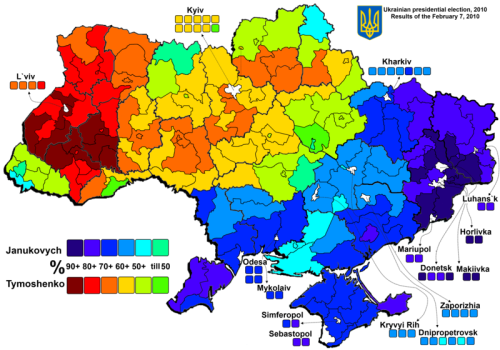
2010 Presidental Elections: regional distribution of the vote obtained by V.Yanukovich and Y.Timoshenko
Given the division of interests that the country faces, the best option for the government would have been to keep the equilibrium between Russia and the EU. It was precisely this double vector policy the one that characterized Leonid Kuchma’s presidency (1994-2004) and the one of Yanukovich until the moment when the EU made a better bet by offering an Association Agreement to Kiev. Moscow tried to disrupt this possibility from the beginning, making Ukraine to understand that EU and Russia were not a compatible choice if Kiev signed the agreement, and that in consequence Yanukovich had to choose.
By keeping the game and the secret negotiations with both sides Yanukovich has deceived himself, misguidedly believing that he could speculate until the last minute while the tension was increasing until achieving a better deal with the EU or Russia. Finally, neither one nor the other has improved the respective bids, but both have increased their pressure over the Ukrainian president, conscious of his weakness. Meanwhile, Ukrainian society has not yet opt clearly for none of the options, and according to the above mentioned surveys, the break between Ukrainians regarding what should be the future of the country is still a reality.
Short-term and mid-term perspectives
Considering all the above analyzed data, it can be stated that in addition to the linguistic and ethnic division of the country, an economic one of material character should be considered, between an Eastern part with socioeconomic dynamics inherited from the Soviet times (huge economic conglomerates and a high level of industrialization) and a Western part with an important agricultural production and a less developed economic structure, where small companies play a major role.
Challenged by historic conjuncture of moving towards either Russia or the EU, Ukraine faces a structural conflict of immediate interests from which will hardly go away with. On one hand, the east claims for a higher rapprochement to Russia in order not to worsen its situation even more, and the west demands to move towards the EU, given its current unfavorable state. These claims quite often are mixed with democratic demands, but also with ethnic and identity issues (mostly from the most radical pro-European factions such as Svoboda) a fact that taken together with the lack of national homogeneity can generate sources of conflict. In this context, the government and the authorities of the country are to a great extent trapped, even more in a moment in which it looked like they have made a definitive commitment with the EU but finally took a step back.
Ukraine has all components of a great regional economy -45 million inhabitants, a powerful agricultural sector, a well developed industrial base, a working population with a good level of preparation, and a quite high level of education-, and even though nowadays it faces hard times (the GDP growth is already two years stagnant), with unity and political determination the country may become a main actor in Eastern Europe in the midterm. In this sense, any proposal from the European side should consider the Ukrainian complexity, a very special case and for which the traditional “take it or leave it” negotiation methods that Brussels has used with the countries of the former socialist bloc do not work. Given the EU’s more than obvious interest on attracting Kiev towards its orbit (to a great extent in order to isolate Russia and contribute to the failure of Customs Union) during the next months Brussels may raise its bid. It may do so by proposing a specific plan that could result more attractive for the Ukrainians as a whole and that would not weaken the economy of the country. If no alternative plans are proposed, the EU may do its best for Yanukovich to lose 2015 presidential elections by increasing support to the opposition. Meanwhile, it is to be expected that Russia will stand pat in its policy of pressure, using customs and gas as weapons. The Ukrainian poker game between Moscow and Brussels goes on.

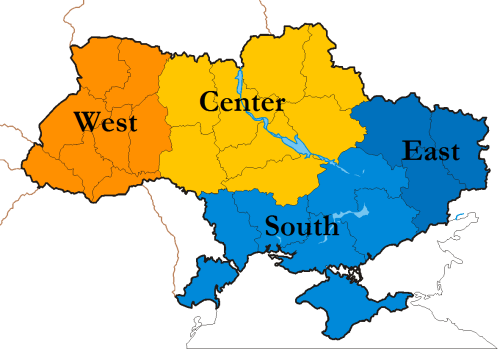
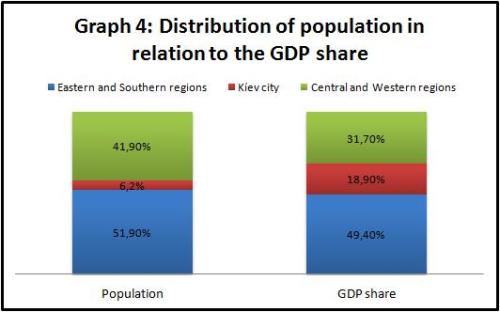
Good job, but it’s not about Ukrainian problem. Well done with numbers and statistics and very superficial view on politics, but it’s nothing to do with what’s really going on in Ukraine. All the numbers you analysed and operated so carefully are surely false as well as results of any kind of election since 2004. To do a good analyses one should get in mind that policy and economy of this country is drown in LIE, CORRUPTION, CRIMINAL GOVERNING AND IN A HUGE INSOLENT THEFT…
Dear Tanya, as stated at the beginning the goal of this article is not so much to analyze the corruption of the Ukrainian political system, but to carry out a sociologic and economic analysis, focusing on the huge divide that characterizes the country, which is something relevant to understand modern Ukraine. All the data comes from independent or public institutes, and are avaliable online. An article focusing on corruption and the oligarchic system is coming soon 🙂 (Btw, I have been in Ukraine around 30 times during the last 7 years, have even lived, worked and studied in Kiev for half a year and I am actually writting this from Novomoskovsk, in Dnipropetrovsk region, so when I deal with Ukraine I know what I am talking about)